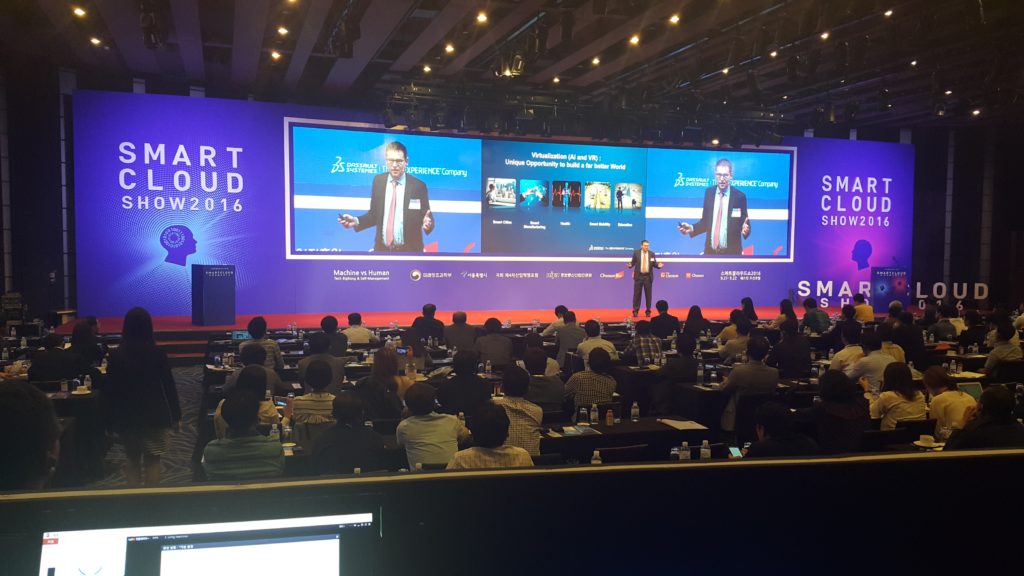I was given the opportunity to make a keynote end of September at the Smart Cloud Show 2016 organized by the Korean newspaper Chosun on the theme smart city and smart manufacturing.
This is in a nutshell, the outline of my presentation:
Our world is at the dawn of an unprecedented transformation from a technical, human, environmental and business point of view.
Let’s see some examples of big issues we are facing and that could become problem of the past.
Every year, 1.3 million die in traffic accidents and 40 million are injured. That’s 3000 killed and more than 100 000 injured per day
5 billion people have no or little access to individual mobility limiting access to job and education when on average, currently a car seat is occupied less than one percent of the time.
One third of the produced food is wasted. That’s enough to feed 2 billion people.
Environmental issues are more and more feared especially global warming.
In the US alone, an estimation says that 250 000 die of medical error every year.
Let’s start with the example of transportation. In 2016, the first experimentation of shared autonomous vehicles is conducted in Singapore and the US. If there is still a driver behind the wheel, it is planned that, thanks to the convergence of on board safety technologies, connectivity and shared economy, the first driver-less services also called “Robot Taxis” could appear as early as 2020. Announcements made this summer by car makes, suppliers, high-tech or transportation companies are converging. There is little doubt that with the exponential acceleration of scientific knowledge and in particular AI, shared autonomous vehicles will become a credible alternative solution to car ownership for middle classes from 2025 onward or even earlier in some places. The impact will be huge in terms of cost (it is estimated that mobility cost could decrease by a factor 3 to 5). As there will be no entry cost, it will also be an accessible transportation solution for most of humankind.
But in conjunction with smart city, the benefits will be even more paramount. A combination of smart homes, smart grids, smart shops and smart mobility will optimize goods production, storage and delivery, transportation and electricity usage.
As a result, life in cities will be considerably improved. Among the expected benefits are: Waste reduction, infrastructure optimization, clean energy use, close to zero traffic accident, city environment improvement, dramatic CO2 emission reduction, accessibility of new services and finally near “zero marginal cost” society.
But combinations of different sectors and sciences will require a new way of managing innovation. “Disrupting” innovations will be the result of collaboration. And working in network is made possible only by using a digital collaboration platform as a single digital space to exchange ideas and information in real time and imagine the future.
Platforms must meet three requirements: Collaboration of course, but also visualization and real time data analytics. Visualization is the common tool to materialize innovative experience for people of different origins and having an updated common origin of shared data ensures that decisions are made faster and more accurately.
Let’s finish by illustrating the limitless possibilities given by those platforms. In the future it will be possible, based on MRI, to computerize ill part of the body of any individual patient as shown by Dassault Systèmes. Then doctors will be able either to “virtually” navigate inside the body and make accurate diagnosis and decide on the best therapy. Through 3D printing, the exact reproduction of the part of the body of each person can be made to help the surgeon to practice. This should ensure a more efficient and less costly therapies with a reduced numbers of medical errors.
Innovative companies will be successful if they forget about top down and bottom up management and enter in the collaboration areas. There are tools to help but they must first enter in a new management form… The Third Road is it! clarify the target and give freedom.
As we enter in an era where most of problems can be solved through innovations, organizations must define their purpose. Superior ideals, like emotions, survive whereas technologies and objects can become obsolete. “To which goal should I contribute?” is the first question each of us should ask and try to answer.

